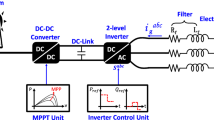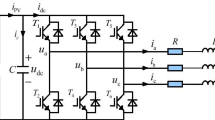Abstract
This paper deals with the control of a five-level grid-connected photovoltaic inverter. Model Predictive Control is applied for controlling active and reactive powers injected into the grid. The operation of the photovoltaic field at the maximum power point is ensured using an algorithm based on a neural network. Model Predictive Control is based on the choice of inverter state by minimizing a cost function that depends on active and reactive powers. In addition, the redundant states of the inverter are directly utilized to balance the bus voltages of the inverter, making overall system control simple and efficient.













Similar content being viewed by others
Abbreviations
- A :
-
P–n junction ideality factor, between 1 and 5
- C 1234 :
-
Dc link capacitances
- E g :
-
Bang-gap energy of the semiconductor used in the cell
- e a,b,c :
-
Three phase voltages of the grid
- e d,q :
-
D-q components of the grid voltage
- i a,b,c :
-
Three phase currents of the grid
- i c 1234 :
-
Currents in dc link capacitors
- i d,q :
-
D-q components of the grid current
- i d 12345 :
-
Input currents of the five level inverter
- i ph :
-
Cell’s photocurrent
- i pv :
-
Output current of PV array
- i RS :
-
Cell’s reverse saturation current at reference temperature and solar irradiation
- i S :
-
Cell’s reverse saturation current
- I N :
-
Output current of the PV array at the Nth sample of time.
- I N −1 :
-
Output current of the PV array at the (N − 1)th sample of time.
- k :
-
Boltzman’s constant, 1.380658 × 10–23 j/K
- k i :
-
Cell’s short-circuit current temperature coefficient
- L :
-
Line inductance of the grid
- N p :
-
Number of panels connected in parallel
- N s :
-
Number of panels connected in series
- q :
-
Electron charge, 1.60217733 × 10–19 Cb
- q ij :
-
Switching signals of the inverter transistors
- R :
-
Line resistance of the grid
- R s :
-
Cell series resistance
- S :
-
Total solar irradiation, W/m2
- T c :
-
Cell’s absolute working temperature, K
- T ref :
-
Cell’s reference temperature, K
- T s :
-
Sampling time used in MPC control
- v c 1234 :
-
Voltages of dc-link capacitors
- V N :
-
Output voltage of the PV array at the Nth sample of time
- V N −1 :
-
Output voltage of the PV array at the (N − 1)th sample of time
- V s :
-
Output voltage vector of the inverter
- v a,b,c :
-
Three phase output voltages of the inverter
- v dc :
-
Output voltage of PV array
- v d,q :
-
D-q components of the output voltage of the inverter
- α :
-
Scaling factor for adjusting the step size of incremental conductance MPPT
- ω :
-
Frequency of grid voltages
References
Rahim NA, Selvaraj J, Krismadinata C (2010) Five-level inverter with dual reference modulation technique for grid-connected PV system. Renew Energy 35(3):712–720. https://doi.org/10.1016/j.renene.2009.08.021
Batiyah S, Zohrabi N, Abdelwahed S, Qunais T, Mousa M (2018) Optimal control design of a voltage controller for stand-alone and grid-connected PV converter. In: Proceedings of the 2018 IEEE Texas power and energy conference (TPEC), pp. 1–6. doi: https://doi.org/10.1109/TPEC.2018.8312094.
Radwan AAA, Mohamed YAI (2016) Power synchronization control for grid-connected current-source inverter-based photovoltaic systems. IEEE Trans Energy Conv 31(3):1023–1036. https://doi.org/10.1109/TEC.2016.2533630
Tan W, Marquez HJ, Chen T (2004) Performance assessment of PID controllers. Control Intel Syst 32(3):158–166. https://doi.org/10.2316/Journal.201.2004.3.201-1309
Lalili D, Mellit A, Lourci N, Medjahed B, Berkouk EM (2011) Input output feedback linearization control and variable step size MPPT algorithm of a grid-connected photovoltaic inverter. Renew Energy 36(12):3282–3291. https://doi.org/10.1016/j.renene.2011.04.027
Lalili D, Mellit A, Lourci N, Medjahed B, Boubakir C (2013) State feedback control and variable step size MPPT algorithm of three-level grid-connected photovoltaic inverter. Sol Energy 98:561–571. https://doi.org/10.1016/j.solener.2013.10.024
Nguyn GMT, Ushida K (2015) Active and reactive power control techniques based on feedback linearization and fuzzy logic for three-phase grid-connected photovoltaic inverters. Asian J Control 17(5):1522–1546. https://doi.org/10.1002/asjc.998
Kumar N, Saha T, Dey J (2016) Sliding-mode control of PWM dual inverter-based grid-connected PV system: modeling and performance analysis. IEEE J Merg Sel Top Power Electron 4(2):435–444. https://doi.org/10.1109/JESTPE.2015.2497900
Touil SA, Boudjerda N, Boubakir A, Drissi KEK (2019) A sliding mode control and artificial neural network based MPPT for a grid-connected photovoltaic source. Asian J Control 21(4):1892–1905. https://doi.org/10.1002/asjc.2007
Lin F, Kuang C, Ke T (2016) Probabilistic wavelet fuzzy neural network basedreactive power control for grid-connected three-phase PV system during gridfaults. Renew Energy 92:437–449. https://doi.org/10.1016/j.renene.2016.02.036
Sun Y, Li S, Lin B, Fu X, Ramezani M, Jaithwa I (2017) Artificial neural network for control and grid integration of residential solar photovoltaic systems. IEEE Trans Sustain Energy 8(4):1484–1495. https://doi.org/10.1109/TSTE.2017.2691669
Khan MA, Haque A, Kurukuru VSB (2020) Intelligent control of a novel transformerless inverter topology for photovoltaic applications. Electr Eng 102:627–641. https://doi.org/10.1007/s00202-019-00899-2
Roselyn JP, Chandran CP, Nithya N, Devaraj D, Venkatesan R, Gopal V, Madhura S (2020) Design and implementation of fuzzy logic based modified real-reactive power control of inverter for low voltage ride through enhancement in grid connected solar PV system. Control Eng Pract 101:104494. https://doi.org/10.1016/j.conengprac.2020.104494
Mechouma R, Mebarki H, Azoui B (2018) Behavior of nine levels NPC three-phase inverter topology interfacing photovoltaic system to the medium electric grid under variable irradiance. Electr Eng 100:2129–2145. https://doi.org/10.1007/s00202-018-0687-7
Viswanathan MP, Anand B (2020) Particle swarm optimization technique for multilevel inverters in solar harvesting micro grid system. Microprocess Microsyst 79:103288. https://doi.org/10.1016/j.micpro.2020.103288
Ishaque K, Salam Z, Shamsudin A, Amjad M (2012) A direct control based maximum power point tracking method for photovoltaic system under partial shading conditions using particle swarm optimization algorithm. Appl Energy 99:414–422. https://doi.org/10.1016/j.apenergy.2012.05.026
Ibrahim A, Aboelsaud R, Obukhov S (2019) Improved particle swarm optimization for global maximum power point tracking of partially shaded PV array. Electr Eng 101:443–455. https://doi.org/10.1007/s00202-019-00794-w
Alnaqi AA, Moayedi H, Shahsavar A, Nguyen TK (2019) Prediction of energetic performance of a building integrated photovoltaic/thermal system thorough artificial neural network and hybrid particle swarm optimization models. Energy Conv Manag 183:137–148. https://doi.org/10.1016/j.enconman.2019.01.005
Ruiz-Rodriguez FJ, Jurado F, Gomez-Gonzalez M (2014) A hybrid method combining JFPSO and probabilistic three-phase load flow for improving unbalanced voltages in distribution systems with photovoltaic generators. Electr Eng 96:275–286. https://doi.org/10.1007/s00202-014-0295-0
Abdmouleh Z, Gastli A, Ben-Brahim L, Haouari M, Al-Emadi NA (2017) Review of optimization techniques applied for the integration of distributed generation from renewable energy sources. Renew Energy 113:266–280. https://doi.org/10.1016/j.renene.2017.05.087
Blaifi S, Moulahoum S, Colak I et al (2018) Monitoring and enhanced dynamic modeling of battery by genetic algorithm using LabVIEW applied in photovoltaic system. Electr Eng 100:1021–1038. https://doi.org/10.1007/s00202-017-0567-6
Harrag A, Messalti S (2018) Adaptive GA-based reconfiguration of photovoltaic array combating partial shading conditions. Neural Comput Appl 30:1145–1170. https://doi.org/10.1007/s00521-016-2757-y
Hammoud I, Morsy K, Abdelrahem M et al (2020) Efficient model predictive power control with online inductance estimation for photovoltaic inverters. Electr Eng 102:549–562. https://doi.org/10.1007/s00202-019-00893-8
Errouissi R, Al-Durra A, Muyeen S (2017) Design and implementation of a nonlinear PI predictive controller for a grid-tied photovoltaic inverter. IEEE Trans Ind Elect 64(2):1241–1250. https://doi.org/10.1109/TIE.2016.2618339
Bighash E, Sadeghzadeha S, Ebrahimzadeh E et al (2018) Improving performance of LVRT capability in single-phase grid-tied PV. Elect Power Energy Syst 98:176–188. https://doi.org/10.1016/j.ijepes.2017.11.034
Samani L, Mirzaei R (2021) Maximum power point tracking for photovoltaic systems under partial shading conditions via modified model predictive control. Electr Eng. https://doi.org/10.1007/s00202-020-01201-5
Exposto B, Rodrigues R, Pinto J, et al (2015) Predictive control of a current-source inverter for solar photovoltaic grid interface. In: Proceedings of the 9th international conference on compatibility and power electronics, Lisbon, Portugal, pp. 113–118, doi: https://doi.org/10.1109/CPE.2015.7231058.
Tang R, Wu Z, Fang Y (2017) Configuration of marine photovoltaic system and its MPPT using model predictive control. Sol Energy 158:995–1005. https://doi.org/10.1016/j.solener.2017.10.025
Sajadian S, Ahmadi R (2016) Model predictive-based maximum power point tracking for grid-tied photovoltaic applications using a Z-source inverter. IEEE Trans Power Elect 31(11):7611–7620. https://doi.org/10.1109/TPEL.2016.2537814
Sajadian S, Ahmadi R (2018) Model predictive controlof dual-mode operations Z-source inverter: islanded and grid-connected. IEEE Trans Power Elect 33(5):4488–4497. https://doi.org/10.1109/ECCE.2017.8096841
Lekouaghet B, Boukabou A, Lourci N et al (2018) Control of PV grid connected systems using MPC technique and different inverter configuration models. Elect Power Syst Res 154:287–298. https://doi.org/10.1016/j.epsr.2017.08.027
Aguirre M, Rojas C, Kouro S (2016) Cascade-free model predictive control of a grid-tie multilevel photovoltaic system. In: Proceedings of the 42nd annual conference of the IEEE industrial electronics society, IECON, pp. 6734–6739, doi: https://doi.org/10.1109/IECON.2016.7793684.
Bonala K, Sandepudi S, Muddineni V (2016) Model predictive current control with modified synchronous detection technique for three-phase 3L-NPC multi-functional solar photovoltaic system. IEEE Int Conf Power Elect Drives Energy Syst (PEDES). https://doi.org/10.1109/PEDES.2016.7914309
Satti MB, Hasan A (2019) Direct model predictive control of novel H-bridge multilevel inverter based grid-connected photovoltaic system. IEEE Access 7:62750–62758. https://doi.org/10.1109/ACCESS.2019.2916195
Nademi H, Soghomonian Z, Norum L (2017) A robust predictive MPPT strategy: An enabler for improving the photovoltaic conversion source. In: IEEE 6th international conference on renewable energy research and applications (ICRERA), pp. 1086–1091, doi: https://doi.org/10.1109/ICRERA.2017.8191223.
Vinod R-K, Singh SK (2018) Solar photovoltaic modeling and simulation: as a renewable energy solution. Energy Rep 4:701–702. https://doi.org/10.1016/j.egyr.2018.09.008
Belkaid A, Colak I, Isik O (2016) Photovoltaic maximum power point tracking under fast varying of solar radiation. Appl Energy 179:523–530. https://doi.org/10.1016/j.apenergy.2016.07.034
Lalili D, Berkouk E, Boudjema F, et al (2008) Self balancing of dc-link capacitor voltages using redundant vectors for SVPWM controlled five-level inverter. In: Fifth international multi-conference on systems, signals and devices, IEEE SSD08, July 20–23, Amman, Jordan, paper reference: SSD08–1569117326. doi: https://doi.org/10.1109/SSD.2008.4632822.
Boudouda A, Boudjerda N, El Khamlichi DK et al (2016) Combined random space vector modulation for a variable speed drive using induction motor. Elect Eng 98:1–15. https://doi.org/10.1007/s00202-015-0341-6
Willems JL (1969) Generalized clarke components for polyphase networks. IEEE Trans Edu 12(1):69–71. https://doi.org/10.1109/TE.1969.4320448
Houssamo I, Locment F, Sechilariu M (2010) Maximum power tracking for photovoltaic power system: development and experimental comparison of two algorithms. Renew Energy 35(10):2381–2387. https://doi.org/10.1016/j.renene.2010.04.006
Hunt KJ, Sbarbaro D, Zbikowski R, Gawthrop PJ (1992) Neural networks for control systems: a survey. Automatica 28(6):1083–1112. https://doi.org/10.1016/0005-1098(92)90053-I
Mellit A, Kalogirou SA (2014) MPPT-based artificial intelligence techniques for photovoltaic systems and its implementation into field programmable gate array chips: review of current status and futur perspectives. Energy 70:1–21. https://doi.org/10.1016/j.energy.2014.03.102
Mao M, Cui L, Zhang K, Zhou L, Huang H (2020) Classification and summarization of solar photovoltaic MPPT techniques: a review based on traditional and intelligant control startegies. Energy Rep 6:1312–1327. https://doi.org/10.1016/j.egyr.2020.05.013
Sano K, Fujita H (2008) Voltage-balancing circuit based on a resonant switched-capacitor converter for multilevel inverters. IEEE Trans Ind Appl 44(6):1768–1776. https://doi.org/10.1109/TIA.2008.2006291
Ashaibi A, Finney SJ, Williams BW, Massoud A (2007) Extend the use of auxiliary circuit to start up, shut down, and balance of the modified diode clamped multilevel inverter. Int Conf Power Elect Drive Syst. https://doi.org/10.1109/PEDS.2007.4487833
Acknowledgements
We would like to thank the Algerian DGRSDT for funding our research through the PRFU research projects of codes A01L07UN180120190003 and A01L07UN180120190005.
Author information
Authors and Affiliations
Corresponding author
Additional information
Publisher's Note
Springer Nature remains neutral with regard to jurisdictional claims in published maps and institutional affiliations.
Rights and permissions
About this article
Cite this article
Bouaouaou, H., Lalili, D. & Boudjerda, N. Model predictive control and ANN-based MPPT for a multi-level grid-connected photovoltaic inverter. Electr Eng 104, 1229–1246 (2022). https://doi.org/10.1007/s00202-021-01355-w
Received:
Accepted:
Published:
Issue Date:
DOI: https://doi.org/10.1007/s00202-021-01355-w




